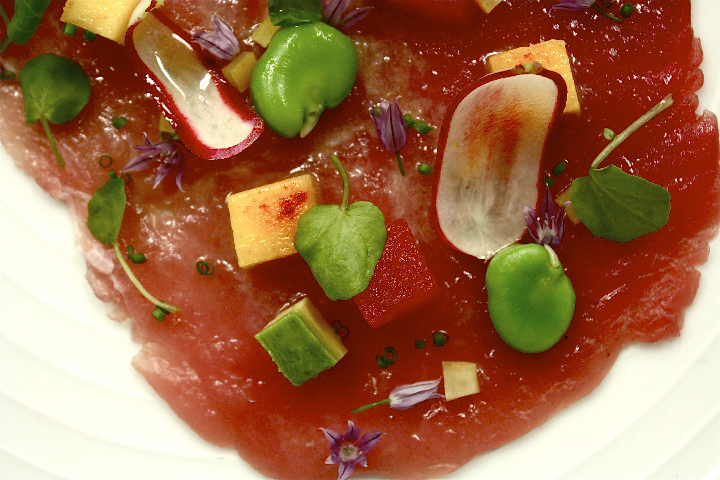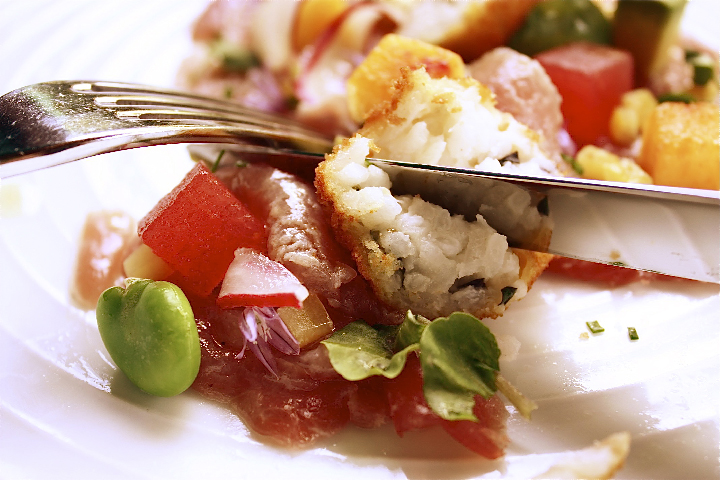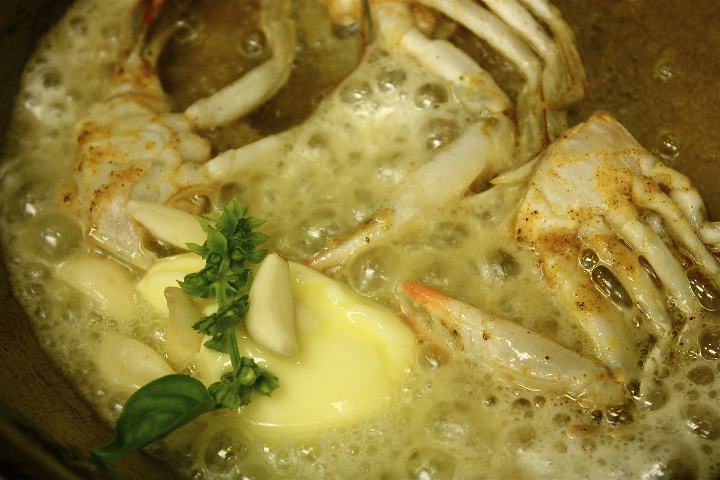Dish of the Week:
Yellow Fin Tuna 'Summer' Carpaccio with Crispy Basil Rice Croquettes
 When Giuseppe Cipriani made the first Carpaccio at Harry’s Bar back in 1950, he had no way of knowing that thousands of recipes for a dish with the same name would follow, or that his creation would move well beyond raw beef to fish, veal and venison. (Then again, as this was the same Giuseppe Cipriani that also ‘invented’ the Bellini cocktail at Harry's, perhaps he did).
When Giuseppe Cipriani made the first Carpaccio at Harry’s Bar back in 1950, he had no way of knowing that thousands of recipes for a dish with the same name would follow, or that his creation would move well beyond raw beef to fish, veal and venison. (Then again, as this was the same Giuseppe Cipriani that also ‘invented’ the Bellini cocktail at Harry's, perhaps he did).
Food lore has it that Cipriani came up with the dish at the behest of a wealthy customer, the countess Amalia Nani Mocenigo, whose doctor had suddenly prescribed a raw meat diet. While culinary history is silent on what in the Countesses' constitution the good Dr was trying to cure (anemia? flagging sexual prowess? ), Amalia found the taste of raw meat repugnant so Giuseppe pounded it paper thin and smothered it in mustard sauce for her.
Whether you pound it with a meat mallet like Giuseppe, or wrap it in saran wrap and just whack it once or twice with the wide end of a chef’s knife as Ryan did with beautiful yellow fin tuna this week, Carpaccio is a dish that has the potential to be a lot more than just a novel technique that transforms a base protein's thickness and texture. Whatever the protein, it’s a dish where a delicate approach is required when it comes to the accompanying sauces, spices, and key ingredients.
 Ryan’s great with dishes like these. For a big man he has an incredibly light, deft touch, coupled with an attention to detail that is immediately apparent in the artistry of his plating well before you take your first bite. While I doubt he ever sits down to count the steps it takes to arrive at the moment when a diner lifts a fork, stops, looks, and thinks, ‘oh my, this is beautiful ’, there are often many laborious ones his crew must practice and master. God is in the details with this guy.
Ryan’s great with dishes like these. For a big man he has an incredibly light, deft touch, coupled with an attention to detail that is immediately apparent in the artistry of his plating well before you take your first bite. While I doubt he ever sits down to count the steps it takes to arrive at the moment when a diner lifts a fork, stops, looks, and thinks, ‘oh my, this is beautiful ’, there are often many laborious ones his crew must practice and master. God is in the details with this guy.
 In the beginning of our professional relationship I often wondered if all this precise cutting, slicing, and dicing ~ though it goes a long way in defining his style ~ was really essential. Most professional and home cooks accept that having ingredients the same size when you are going to apply heat is important ~ but until Ryan came along I never considered how synchronicity can be a game changer when it comes to what we taste.
In the beginning of our professional relationship I often wondered if all this precise cutting, slicing, and dicing ~ though it goes a long way in defining his style ~ was really essential. Most professional and home cooks accept that having ingredients the same size when you are going to apply heat is important ~ but until Ryan came along I never considered how synchronicity can be a game changer when it comes to what we taste.
This week’s Yellow Fin Tuna Carpaccio is a case in point. Ryan conceived the dish as a play on sushi and rice, one that takes Yellow Fin Tuna for a jaunt through a bountiful Sonoma County summer field at the height of August. Avocado, watermelon and golden beets ~ all cut to exact dimensions ~ brought key elements of creamy, refreshing and earthy to the plate. Even with light assist from favas, chive flowers and purslane, everything on the final plate was meant to dance with (and around) the fragrant flavor and almost transparent texture of the tuna ~ enhancing, but never dominating its subtle taste. The visual joy of Chef's plating wasn't subsidiary to the success of the dish, but an elaborate seduction, through color and form, integral to the experience of eating it. But that wasn't all. He also had a few surprises in store.
 The first was a deliciously crispy basil rice ball that referenced the sushi while extending its normally cold bland taste profile with surprising heat and crunch. By using Carnaroli rice instead of Nishiki (Sushi rice), and a touch of pecorino, Chef also brought more cream to the bite instigating an Asia meets Italy moment. Then there were the bright flecks of preserved lemon rind scattered through the dish which exploded in tiny bursts when you least expected it. Not sweet, but not overwhelmingly tart either they had the effect of bringing all the other subdued flavors forward while paying direct respect ~ as only citrus can ~ to the fresh fish taste of the tuna.
The first was a deliciously crispy basil rice ball that referenced the sushi while extending its normally cold bland taste profile with surprising heat and crunch. By using Carnaroli rice instead of Nishiki (Sushi rice), and a touch of pecorino, Chef also brought more cream to the bite instigating an Asia meets Italy moment. Then there were the bright flecks of preserved lemon rind scattered through the dish which exploded in tiny bursts when you least expected it. Not sweet, but not overwhelmingly tart either they had the effect of bringing all the other subdued flavors forward while paying direct respect ~ as only citrus can ~ to the fresh fish taste of the tuna.
 The lemons had been preserved in equal parts of salt and sugar five months ago. I don't mind harping on it: preserved lemons are a really great condiment to keep around. Traditionally stored in ceramic or glass jars, Ryan uses sous vide pouches to cure and hold them, which take much less space in the fridge and uniformly bathes the lemons so you never even have to turn them (a great help if, like me, you always forget anyway).
The lemons had been preserved in equal parts of salt and sugar five months ago. I don't mind harping on it: preserved lemons are a really great condiment to keep around. Traditionally stored in ceramic or glass jars, Ryan uses sous vide pouches to cure and hold them, which take much less space in the fridge and uniformly bathes the lemons so you never even have to turn them (a great help if, like me, you always forget anyway).
Every mouthful of this dish was about what’s best in summer here in Sonoma County. Whatever ailed her, I'm betting The Countess would have loved it.
New In the Gallery
 WOVEN WITH PASSION, NOT WITH POWER is the mantra of SlowColor, a company that produces extraordinarily beautiful linen textiles we have just started selling in the gallery. Made in and around Hyderabad, India, exclusively on small pedal looms using only natural plant dyes, this politically focused enterprise was started by two Americans, Jala Pfaff and Sanjay Rajan, who hope their C2C (cradle to cradle) efforts will help keep ancient textile traditions alive by providing commerce to the hundreds of hand loom and natural dye co-ops struggling to survive in India. It wasn’t long ago we wrote about the tragic increase of small farmer suicides in that country which were directly triggered by a Monsanto-led movement which encouraged mega-scale chemically dependent farming over the small and sustainable methods India has used for centuries. (Courting Armageddon, April 28, 2010) Well, it seems that for some time now thousands of small village textile weavers and dyers have also been driven to take their lives faced with obsolesce as the world has increasingly moved toward large scale factory production.
WOVEN WITH PASSION, NOT WITH POWER is the mantra of SlowColor, a company that produces extraordinarily beautiful linen textiles we have just started selling in the gallery. Made in and around Hyderabad, India, exclusively on small pedal looms using only natural plant dyes, this politically focused enterprise was started by two Americans, Jala Pfaff and Sanjay Rajan, who hope their C2C (cradle to cradle) efforts will help keep ancient textile traditions alive by providing commerce to the hundreds of hand loom and natural dye co-ops struggling to survive in India. It wasn’t long ago we wrote about the tragic increase of small farmer suicides in that country which were directly triggered by a Monsanto-led movement which encouraged mega-scale chemically dependent farming over the small and sustainable methods India has used for centuries. (Courting Armageddon, April 28, 2010) Well, it seems that for some time now thousands of small village textile weavers and dyers have also been driven to take their lives faced with obsolesce as the world has increasingly moved toward large scale factory production.
All text Jil Hales. All photos Jil Hales and Dawid Jaworski (unless otherwise noted)















